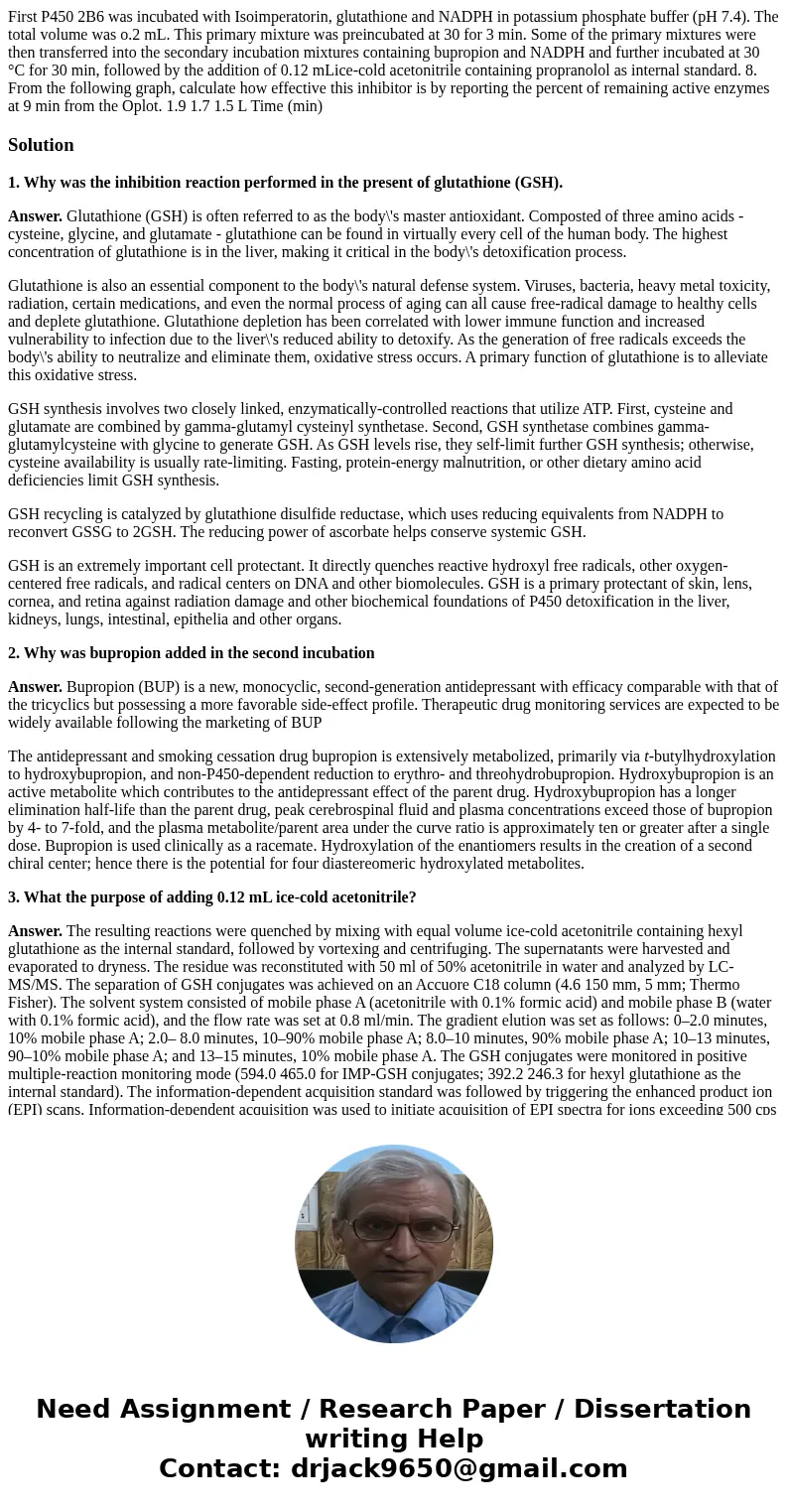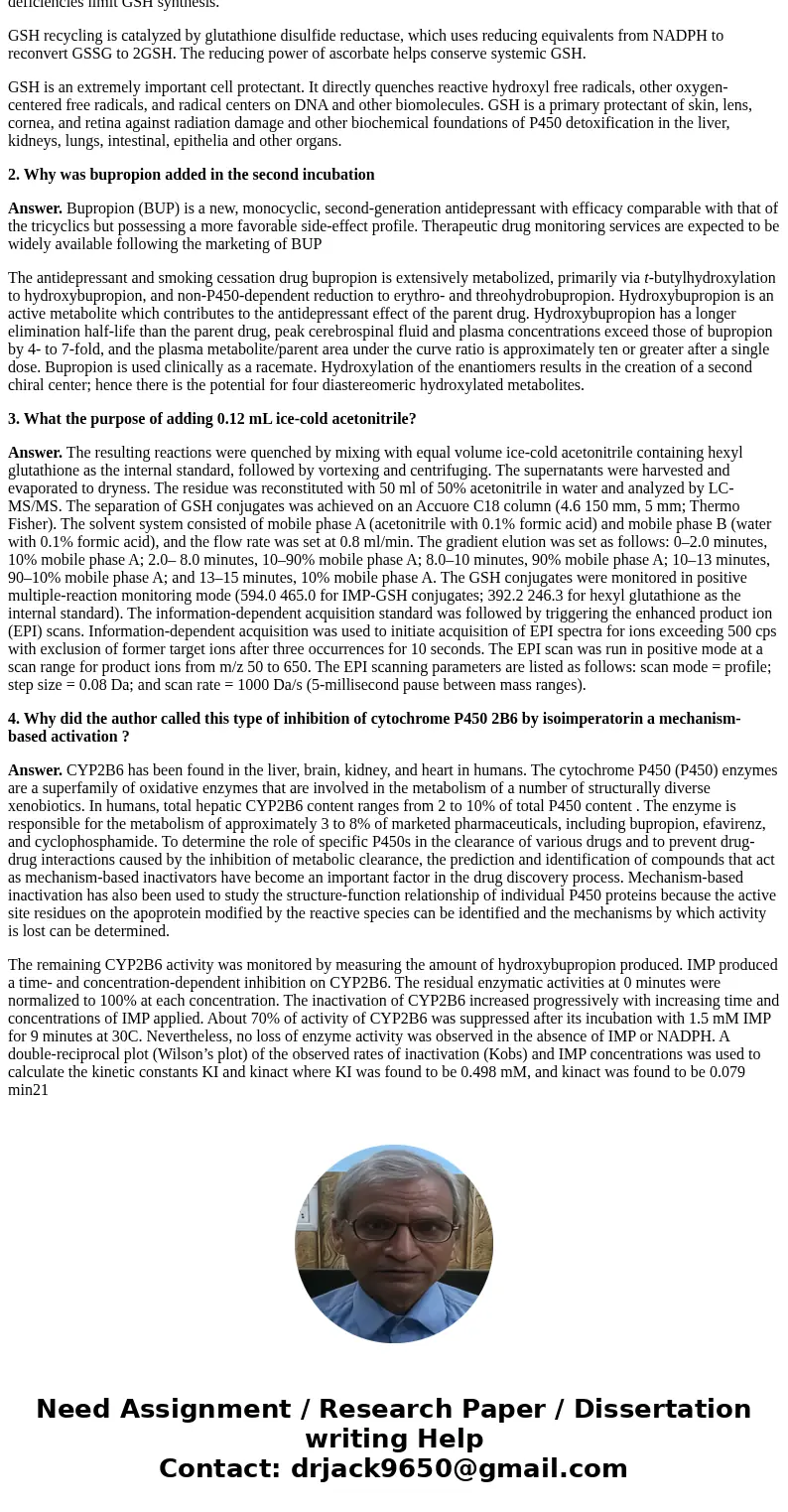First P450 2B6 was incubated with Isoimperatorin glutathione
Solution
1. Why was the inhibition reaction performed in the present of glutathione (GSH).
Answer. Glutathione (GSH) is often referred to as the body\'s master antioxidant. Composted of three amino acids - cysteine, glycine, and glutamate - glutathione can be found in virtually every cell of the human body. The highest concentration of glutathione is in the liver, making it critical in the body\'s detoxification process.
Glutathione is also an essential component to the body\'s natural defense system. Viruses, bacteria, heavy metal toxicity, radiation, certain medications, and even the normal process of aging can all cause free-radical damage to healthy cells and deplete glutathione. Glutathione depletion has been correlated with lower immune function and increased vulnerability to infection due to the liver\'s reduced ability to detoxify. As the generation of free radicals exceeds the body\'s ability to neutralize and eliminate them, oxidative stress occurs. A primary function of glutathione is to alleviate this oxidative stress.
GSH synthesis involves two closely linked, enzymatically-controlled reactions that utilize ATP. First, cysteine and glutamate are combined by gamma-glutamyl cysteinyl synthetase. Second, GSH synthetase combines gamma-glutamylcysteine with glycine to generate GSH. As GSH levels rise, they self-limit further GSH synthesis; otherwise, cysteine availability is usually rate-limiting. Fasting, protein-energy malnutrition, or other dietary amino acid deficiencies limit GSH synthesis.
GSH recycling is catalyzed by glutathione disulfide reductase, which uses reducing equivalents from NADPH to reconvert GSSG to 2GSH. The reducing power of ascorbate helps conserve systemic GSH.
GSH is an extremely important cell protectant. It directly quenches reactive hydroxyl free radicals, other oxygen-centered free radicals, and radical centers on DNA and other biomolecules. GSH is a primary protectant of skin, lens, cornea, and retina against radiation damage and other biochemical foundations of P450 detoxification in the liver, kidneys, lungs, intestinal, epithelia and other organs.
2. Why was bupropion added in the second incubation
Answer. Bupropion (BUP) is a new, monocyclic, second-generation antidepressant with efficacy comparable with that of the tricyclics but possessing a more favorable side-effect profile. Therapeutic drug monitoring services are expected to be widely available following the marketing of BUP
The antidepressant and smoking cessation drug bupropion is extensively metabolized, primarily via t-butylhydroxylation to hydroxybupropion, and non-P450-dependent reduction to erythro- and threohydrobupropion. Hydroxybupropion is an active metabolite which contributes to the antidepressant effect of the parent drug. Hydroxybupropion has a longer elimination half-life than the parent drug, peak cerebrospinal fluid and plasma concentrations exceed those of bupropion by 4- to 7-fold, and the plasma metabolite/parent area under the curve ratio is approximately ten or greater after a single dose. Bupropion is used clinically as a racemate. Hydroxylation of the enantiomers results in the creation of a second chiral center; hence there is the potential for four diastereomeric hydroxylated metabolites.
3. What the purpose of adding 0.12 mL ice-cold acetonitrile?
Answer. The resulting reactions were quenched by mixing with equal volume ice-cold acetonitrile containing hexyl glutathione as the internal standard, followed by vortexing and centrifuging. The supernatants were harvested and evaporated to dryness. The residue was reconstituted with 50 ml of 50% acetonitrile in water and analyzed by LC-MS/MS. The separation of GSH conjugates was achieved on an Accuore C18 column (4.6 150 mm, 5 mm; Thermo Fisher). The solvent system consisted of mobile phase A (acetonitrile with 0.1% formic acid) and mobile phase B (water with 0.1% formic acid), and the flow rate was set at 0.8 ml/min. The gradient elution was set as follows: 0–2.0 minutes, 10% mobile phase A; 2.0– 8.0 minutes, 10–90% mobile phase A; 8.0–10 minutes, 90% mobile phase A; 10–13 minutes, 90–10% mobile phase A; and 13–15 minutes, 10% mobile phase A. The GSH conjugates were monitored in positive multiple-reaction monitoring mode (594.0 465.0 for IMP-GSH conjugates; 392.2 246.3 for hexyl glutathione as the internal standard). The information-dependent acquisition standard was followed by triggering the enhanced product ion (EPI) scans. Information-dependent acquisition was used to initiate acquisition of EPI spectra for ions exceeding 500 cps with exclusion of former target ions after three occurrences for 10 seconds. The EPI scan was run in positive mode at a scan range for product ions from m/z 50 to 650. The EPI scanning parameters are listed as follows: scan mode = profile; step size = 0.08 Da; and scan rate = 1000 Da/s (5-millisecond pause between mass ranges).
4. Why did the author called this type of inhibition of cytochrome P450 2B6 by isoimperatorin a mechanism- based activation ?
Answer. CYP2B6 has been found in the liver, brain, kidney, and heart in humans. The cytochrome P450 (P450) enzymes are a superfamily of oxidative enzymes that are involved in the metabolism of a number of structurally diverse xenobiotics. In humans, total hepatic CYP2B6 content ranges from 2 to 10% of total P450 content . The enzyme is responsible for the metabolism of approximately 3 to 8% of marketed pharmaceuticals, including bupropion, efavirenz, and cyclophosphamide. To determine the role of specific P450s in the clearance of various drugs and to prevent drug-drug interactions caused by the inhibition of metabolic clearance, the prediction and identification of compounds that act as mechanism-based inactivators have become an important factor in the drug discovery process. Mechanism-based inactivation has also been used to study the structure-function relationship of individual P450 proteins because the active site residues on the apoprotein modified by the reactive species can be identified and the mechanisms by which activity is lost can be determined.
The remaining CYP2B6 activity was monitored by measuring the amount of hydroxybupropion produced. IMP produced a time- and concentration-dependent inhibition on CYP2B6. The residual enzymatic activities at 0 minutes were normalized to 100% at each concentration. The inactivation of CYP2B6 increased progressively with increasing time and concentrations of IMP applied. About 70% of activity of CYP2B6 was suppressed after its incubation with 1.5 mM IMP for 9 minutes at 30C. Nevertheless, no loss of enzyme activity was observed in the absence of IMP or NADPH. A double-reciprocal plot (Wilson’s plot) of the observed rates of inactivation (Kobs) and IMP concentrations was used to calculate the kinetic constants KI and kinact where KI was found to be 0.498 mM, and kinact was found to be 0.079 min21


 Homework Sourse
Homework Sourse